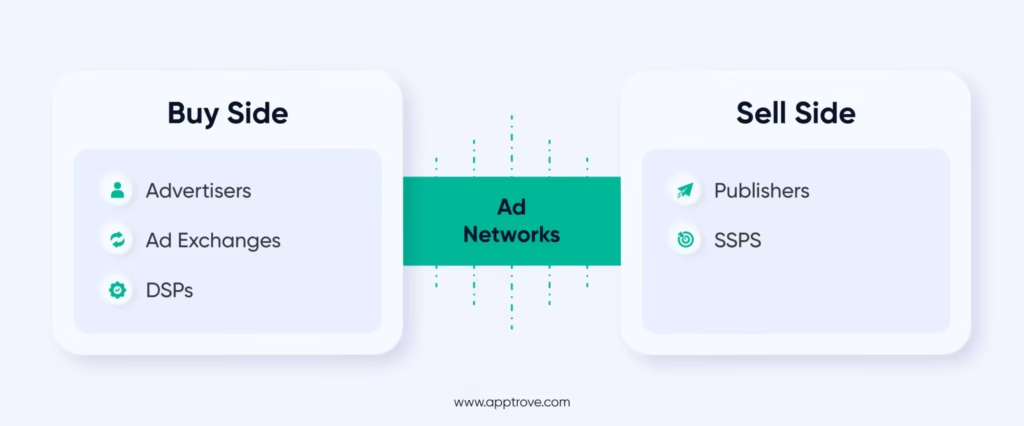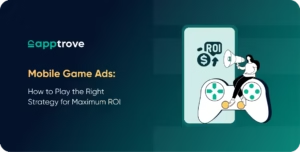With 82% of mobile ad impressions coming from them, in-app advertising comes across as one of the fastest and most effective mobile advertising tactics. It serves as a powerful tool for app user acquisition.
And why not? In-app advertising lets you capture users with laser precision and level up the quality of audience insights from your campaigns. Thus, having a well-defined in-app advertising strategy has become a necessity.
But before you can start working on a full-fledged in-app mobile advertising campaign for your mobile app, it’s important to understand the ecosystem.
An Overview of the In-App Advertising Ecosystem
In-app advertising is the practice of displaying paid ads within the mobile app, enabling app owners and marketers to leverage their real estate by selling the space to advertisers. Advertisers, on the other hand, benefit from the visibility of their brands on popular apps.
These ads are facilitated by programmatic ad buying and served through mobile app ad networks.
How It Works
In-app advertising works with multiple players collaborating in an automated process to deliver content to app users.
When your app triggers a request for an ad, the in-app advertising networks utilize algorithms to deliver a high-quality ad to users in real time.
As such, there are two sides involved in mobile in-app advertising- the buy side consisting of advertisers that buy the ad space, and the sell side consisting of publishers that sell it.
Here’s a quick graphic that gives an overview of all the stakeholders within the in-app advertisement ecosystem.

Buy-side stakeholders:
- Advertisers: These are marketers and brands that buy space for displaying their advertisements.
- Ad Exchanges: These are like stock exchanges for advertisements, wherein advertisers can select a target audience and bid for advertising to them.
- Demand-Side Platforms (DSPs): These are platforms that will let advertisers access several ad exchanges
Sell-side stakeholders:
- Publishers: these are the applications that want to monetize and in the market for selling ad space
- Supply-Side Platforms (SSPs): These are platforms that let ad space sellers or publishers show ads to the selected audience
Ad networks act as the mediator or broker that helps advertisers get access to publisher ad space.
A key entity you should know about as a marketer is Mobile Measurement Partners (MMPs). These are platforms that measure the performance of ad campaigns and attribute successful outcomes to the corresponding ad networks.
Even though MMPs are independent entities in the in-app advertising ecosystem, they determine which ad networks to leverage for campaigns.
Now that we are clear on how the in-app advertising ecosystem works, let us look at some of the best practices that you should follow.
7 Effective In-App Advertising Best Practices
1. Understand the User Journey
Tracking user behavior and activities is key to understanding their journey and creating clear audience segments. Audience segments say a lot about behavior, preferences, or goals.
Besides, tracking in-app behavior and events helps in determining what offers the most value to users. All this data is valuable to marketers looking to place in-app ads.
What’s more, you can use these insights to tweak the user journey and optimize it to target high-value users.
Apptrove offers an exclusive deep linking suite that lets you capitalize on these insights and create powerful customer experiences with the help of Unilinks. Thus, you can create seamless customer experiences across platforms and channels with an improved focus on ROAS analytics.
2. Experiment with a Variety of In-App Ad Formats
You might think advertising in apps while a user is using it might limit advertisers in terms of creativity, but the best part about it is that you have a plethora of mobile ad formats to choose from. Ensure to choose the ad format that goes well with your app flow and is likely to get more engagement from your users.
Having said that here are some of the popular in-app ad formats that you should consider as a publisher:
- Banner Ads
- Video Ads
- Native Ads
- Rewarded Video Ads
- Interstitial Ads
- Playable Ads
You can read more about these ad formats in our detailed post here.
Since these are interactive ads, they are perceived positively by users as they do not disrupt their in-app experience. At the same time, playable ads deliver some of the highest ROAS among ad formats.
3. Invest in Creating Quality Creatives
Finding enough real estate for in-app advertising has become complicated due to its popularity. For every great app, several others are selling ad space and want to monetize their app.
With so many marketers and brands to compete with, you should know that the quality of the creatives and content on your app will make all the difference. Advertisers are likely to go for apps that have content that drives more engagement out of users.
The right combination of creatives, high-quality content, and a unique user experience can boost the performance of your app and the quality of advertisers you attract.
4. Test App Quality and Viewability
As a publisher, you will only be able to guarantee results that you can generate through your app. It is a good idea to test the quality of your app before approaching an SSP for placing ads on it. After all, the cost of in-app advertising is constantly rising and advertisers like to know that they have picked the right app to advertise on.
Moreover, as per the guidelines shared by the Media Rating Council (MRC) and Interactive Advertising Bureau, these conditions should be met for an ad to be viewable:
- At least 50% of the ad pixels were in view.
- After ad-render, this pixel requirement should be met for greater than or equal to one continuous second.
Analyze the ads with metrics, such as Measured Rate, Viewable Rate, and Impression Distribution to determine whether the ad viewability in the app meets the MRC specifications.
You can also test the ad networks you are utilizing for ad requests by changing them and checking their impact on CPM (Cost Per Mille) and in-app advertising revenue.
5. Stay on Top of Privacy Regulations
With security threats looming on the horizon for every mobile app all the time, you can never be too careful with your security policies and actions. It is important to ensure that you take care of the privacy and security guidelines about your mobile app and regions of operations.
At Apptrove, we adhere to several international privacy standards, such as GDPR and CCPA. We are also ISO 27001 certified and use AES256 encryption to ensure that your data is always under a tight lockdown.
6. Track, Test, and Analyze with A/B Testing
In-app advertising campaigns can only be effective with the right mechanisms supporting them. While advertisers are already likely to track and test their ads, it is a good idea to do the same regularly for your app.
For every in-app ad campaign, track the most crucial KPIs and metrics such as:
- Impressions: In the context of mobile in-app advertising, impressions are the total number of times your ad is displayed on an app. This metric will give you an idea of the potential increase in your brand awareness. However, impressions do not guarantee that an ad was seen by a user, only that it was displayed.
- Click-Through Rate: It tells you the number of users who clicked on your ad from the ones who viewed it.
- CPM (Cost-Per-Mille): CPM or Cost per mille refers to the bid you pay for every thousand views your ads get on a specific ad network.
- CPC (Cost-Per-Click): The total amount you pay for every click you get on your advertisement is calculated by this metric.
- Conversion: You can track micro conversions (specific activity like email signups or subscriptions) or macro conversions (completed purchases), depending on what your end goal with the advertisement is.
Based on what these metrics tell you, narrow down the formats and content that work for your users. Also, deploy A/B testing to compare and analyze different versions of the same ad and check which one is likely to perform better.
You can provide all of these valuable insights to any advertiser who is looking to promote to an engaged user group.
7. Choose a Suitable MMP
When pitching for ad campaigns on various ad networks, choosing the right MMP is an important step to consider. The platform must point to the strengths and weaknesses of the advertising campaign, allowing you to tweak your strategy.
Consider these primary factors when choosing an MMP to manage your in-app advertising campaigns:
- Anti-Fraud Protection
Fraudulent ads and app installs pose a big challenge in the mobile marketing realm. The cost of ad fraud in 2023 alone was predicted to be over $100 billion. Hence, the MMP you choose must have robust anti-fraud features.
Apptrove offers 7-layered fraud protection settings that you can adjust as per your need. We also provide custom fraud shields that help you create a strong fraud prevention strategy while assigning highly specific and custom rules for every ad campaign and partner.
Additionally, you can add your validation rules to filter out and eliminate any modern fraudulent tactics. - Access to Detailed Insights and Analytics
What is an MMP if it fails to offer access to detailed insights and analytics? Invest in an MMP that offers comprehensive reporting based on the data and insights you are looking for. Moreover, the dashboard should be free of clutter and easy to use.
Apptrove lets you access deeper audience insights by connecting the dots between user acquisition and lifetime value. The dashboard is neat and highlights the channels that deliver the highest ROI so that you can optimize your ad spend accordingly.
Besides, with SKAN Analytics for tracking iOS-related insights, you can visualize the most complex data easily with graphs and charts. - Commitment to Data Privacy
One of the biggest challenges in mobile attribution is doing it without compromising the data privacy and integrity of your brand and customers. The MMP you opt for should uphold security and privacy requirements.
Apptrove provides a multi-layered defense system including anti-DDoS mechanisms, API shields, clear data retention policies, and AS256 encryption for data.
What’s more, the credibility of the privacy measures offered by Apptrove can be validated by the GDPR, ISO 27001, ePrivacy, and CCPA certifications. - Alignment of Features with Your Business Goals
Above all, the MMP should align with the goals you have set for your business.
Apptrove offers a suite of features to propel your campaigns. It is tailored for business growth, You can get the necessary insights to increase app installs, improve campaign ROI, enhance user LTV, and optimize ad performance.
- Empower your retargeting process by building hyper-personalized ad campaigns with the help of Unilinks. Apptrove is powered with robust deep-linking capabilities that make every touch count, enabling you to create seamless customer experiences across platforms.
- Ability to map out seamless user journeys by tracking each click associated with your campaigns.
- Access to deeper audience insights to optimize your ad spending and maximize marketing ROI.
- Data-driven decision-making empowered by powerful insights and analytics.
- SKAN Analytics to uncover valuable iOS insights and track acquisition and engagement trends across the iOS landscape.
- Quality of Customer Support
The MMP you choose must offer adequate assistance and support in your onboarding journey and beyond.
With Apptrove, you not only get 24×7 support but also get access to an army of account managers, dedicated customer success managers, and tech specialists who work to resolve your queries. You can get in touch with our customer support using email, Skype, or direct phone calls. We also offer a seamless ticket management system to listen to and resolve your concerns.
Summing Up
In-app advertising for mobile apps can get quite complex if you do not utilize the right strategies or approach to drive the process. To reap the benefits of in-app advertising campaigns, you must not just implement the tactics shared above but also invest in an MMP to track and optimize your campaigns.
Apptrove is a mobile marketing attribution tool that will help you generate detailed data and analytics from your in-app advertising campaign. This will let you make informed decisions while adhering to data regulations.
Ready to take control of your in-app advertising with a platform built for simplicity and insights? Talk to our sales team now for a personalized walkthrough of the features and see firsthand how Apptrove unearths actionable insights for you.
FAQs
1. What is in-app advertising and how does it work?
In-app advertising is when you show paid advertisements in mobile apps. It happens automatically; advertisers and publishers don’t work directly with each other—they communicate through DSP (Demand Side Platforms) and SSPs (Supply Side Platforms) and ad networks serve ads to users that are a match using LightSpeed, the most real time of real time advertising technologies.
2. Who are the main players in this ecosystem?
There are two sides: the buy side (advertisers, ad exchanges, DSPs) and the sell side (publishers, SSPs). The ad networks serve like the middleman, where a lot of communication happens. Mobile Measurement Partners (MMPs) act as partners for tracking and attribution of campaign results, so they may serve the market as the third side.
3. Which ad formats deliver the best results?
Types of ads include banners, videos, native ads, rewarded, interstitials, and playable. While rewarded and payable units tend to generate the greatest engagement and ROAS, since they deliver some value to the user, while also not interrupting the user experience.
4. Why are MMPs essential for mobile campaigns?
MMPs track performance, match installs or conversions to the right channels, fraud protection, privacy compliance, and reporting & analytics for easier decision-making when spending.
5. What are some best practices for success?
1. Map user journeys and segment audiences.
2. Experiment with different ad types.
3. Focus on creative quality.
4. Monitor viewability with metrics.
5. Stay compliant with privacy rules.
6. Use A/B testing for insights.
7. Partner with a reliable MMP.






